Sensitive and Cost-Effective TLC-Densitometric Method for Determination of Metronidazole and Tinidazole in Tablets
Abstract
1. Introduction
2. Materials and Methods
2.1. Chemicals and Reference Standards
2.2. Standard Solutions of Active Pharmaceutical Ingredients (APIs)
2.3. Solutions of Metronidazole and Tinidazolum
2.4. TLC-Densitometry
2.5. TLC Method Validation
2.6. Quantitative Analysis of Metronidazole and Tinidazole in Tablets and Comparison with Pharmacopeial Method
2.7. Statistical Analysis
3. Results and Discussion
3.1. Validation
3.1.1. Optimization of Chromatographic Conditions
3.1.2. Linearity and Range
3.1.3. Precision
3.1.4. Accuracy
3.1.5. Limit of Detection (LOD) and Limit of Quantification (LOQ)
3.1.6. Robustness
3.2. Quantitative Analysis of M and T in Tablets and Comparison with Pharmacopeial Method
4. Conclusions
Supplementary Materials
Funding
Data Availability Statement
Conflicts of Interest
References
- Polish Pharmaceutical Society. Polish Pharmacopoeia X; Polish Pharmaceutical Society: Warsaw, Poland, 2014. (In Polish) [Google Scholar]
- United States Pharmacopeial Convention. The United States Pharmacopoeia, 34th ed.; United States Pharmacopeial Convention: Rockville, MD, USA, 2011. [Google Scholar]
- Komsta, Ł.; Waksmundzka-Hajnos, M.; Sherma, J. Thin Layer Chromatography in Drug Analysis, 1st ed.; CRC Press: Boca Raton, FL, USA, 2014. [Google Scholar]
- Sherma, J.; Fried, B. Handbook of Thin Layer Chromatography, 3rd ed.; Revise and Expanded; Marcel Dekker, Inc.: New York, NY, USA, 2003. [Google Scholar]
- Bober, K.; Bębenek, E.; Boryczka, S. Application of TLC for evaluation of the lipophilicity of newly synthetized esters: Betulin derivatives. J. Anal. Methods Chem. 2019, 2019, 1297659. [Google Scholar] [CrossRef] [PubMed]
- Bębenek, E.; Bober-Majnusz, K.; Siudak, S.; Chrobak, E.; Kadela-Tomanek, M.; Wietrzyk, J.; Boryczka, S. Application of TLC to evaluate the lipophilicity of newly synthesized betulin derivatives. J. Chromatogr. Sci. 2020, 58, 323–333. [Google Scholar] [CrossRef]
- Wicha-Komsta, K.; Komsta, Ł. Unconventional TLC systems in lipophilicity determination: A review. J. Liq. Chromatogr. Rel. Technol. 2017, 40, 219–225. [Google Scholar] [CrossRef]
- Pastewska, M.; Bednarczyk-Cwynar, B.; Kovačević, S.; Buławska, N.; Ulenberg, S.; Georgiev, P.; Kapica, H.; Kawczak, P.; Bączek, T.; Sawicki, W.; et al. Multivariate assessment of anticancer oleanane triterpenoids lipophilicity. J. Chromatogr. A 2021, 1656, 462552. [Google Scholar] [CrossRef]
- Nagi, D.M.; Abdelgaleel, M.; Derayea, S.M.; Khashaba, P.Y. Studying the kinetic of midodrine degradations using TLC stability approach: Application to dosage form and human plasma. J. Pharm. Biomed. Anal. 2023, 229, 115322. [Google Scholar] [CrossRef]
- Shah, D.A.; Gondalia, I.I.; Patel, V.B.; Mahajan, A.; Chhalotiya, U.; Nagda, D.C. Stability indicating thin-layer chromatographic method for estimation of antidiabetic drug Remogliflozin etabonate. Futur J. Pharm. Sci. 2021, 7, 83. [Google Scholar] [CrossRef]
- Soudi, A.T.; Hussein, O.G.; Elzanfaly, E.S.; Zaazaa, H.E.; Abdelkawy, M. Stability indicating TLC–densitometric method for determination of alcaftadine in presence of its degradation products and dosage form preservatives. Res. J. Pharm. Technol. 2020, 13, 5171–5176. [Google Scholar] [CrossRef]
- Yeniceli Uğur, D.; Uğur, A. Analysis of anticancer drugs using thin layer chromatography—A review. Marmara Pharm. J. 2018, 22, 334–346. [Google Scholar] [CrossRef]
- Sherma, J.; Rabel, F. Advances in the thin layer chromatographic analysis of counterfeit pharmaceutical products: 2008–2019. J. Liq. Chromatogr. Rel. Technol. 2019, 42, 367–379. [Google Scholar] [CrossRef]
- Cvetanovski, F.; Brezovska, K.; Poceva Panovska, A.; Tonic Ribarska, J.; Sterjev, Z.; Grozdanova, A.; Netkovska, K. Counterfeiting of medicines as an infringement of the intellectual property rights. Maced. Pharm. Bull. 2016, 62, 85–89. [Google Scholar] [CrossRef]
- Pathak, R.; Gaur, V.; Sankrityayan, H.; Gogtay, J. Tackling counterfeit drugs: The challenges and possibilities. Pharm. Med. 2023, 37, 281–290. [Google Scholar] [CrossRef]
- Ali, N.W.; Gamal, M.; Abdelkawy, M. Chromatographic methods for simultaneous determination of di-iodohydroxyquinoline and metronidazole in their binary mixture. Pak. J. Pharm. Sci. 2013, 26, 865–871. [Google Scholar]
- Salem, H.; Riad, S.; Rezk, M. Simultaneous determination of metronidazole and diiodohydroxyquine in bulk powder and aaramibe compound tablets by TLC-densitometry and HPLC. Pharm. Anal. Acta 2012, 10, 2153–2423. [Google Scholar]
- Maher, H.M.; Youssef, R.M. Development of validated chromatographic methods for the simultaneous determination of metronidazole and spiramycin in tablets. Chromatographia 2009, 69, 345–350. [Google Scholar] [CrossRef]
- Kavitha, J.; Kishore, C.H.; Lakshmi, K.S. Simultaneous estimation of metronidazole, furazolidone and loperamide by HPTLC in veterinary formulation. Int. J. Pharm. Sci. 2013, 5, 620–625. [Google Scholar]
- Tendolkar, N.M.; Desai, B.S.; Gaudh, J.S.; Shinde, V.M. Simultaneous determination of tinidazole and furazolidone in suspension by HPTLC and HPLC. Anal. Lett. 1995, 28, 1641–1653. [Google Scholar] [CrossRef]
- Sharma, S.; Sharma, M.C. Development and validation of densitometric method for metronidazole and tetracycline hydrochloride in capsule dosage form. Int. J. Pharma Tech. Res. 2011, 3, 1169–1173. [Google Scholar]
- Elkady, E.F.; Mahrouse, M.A. Reversed-phase ion-pair HPLC and TLC-densitometric methods for the simultaneous determination of ciprofloxacin hydrochloride and metronidazole in tablets. Chromatographia 2011, 73, 297–305. [Google Scholar] [CrossRef]
- Morcoss, M.M.; Abdelwahab, N.A. Different chromatographic methods for simultaneous determination of diloxanide furoate, metronidazole and its toxic impurity. J. Iran. Chem. Soc. 2016, 13, 1643–1651. [Google Scholar] [CrossRef]
- Meshram, D.B.; Bagade, S.B.; Tajne, M.R. TLC-densitometric analysis of clotrimazole and metronidazole in combined dosage forms. J. Planar. Chromatogr.—Mod. TLC 2008, 21, 277–282. [Google Scholar] [CrossRef]
- Meshram, D.; Patel, D.; Rohit, M.; Desai, S.; Tajne, M.R. Simultaneous determination of clotrimazole and tinidazole in tablet and cream by HPTLC. Int. J. Adv. Res. 2014, 2, 855–863. [Google Scholar]
- Patel, S.K.; Kapupara, P.P.; Shah, K.V. Simultaneous estimation of clotrimazole and tinidazole in pharmaceutical formulation by HPTLC. Int. J. Res. Dev. Pharm. Life Sci. 2015, 4, 1635–1640. [Google Scholar]
- Salem, H.; Riad, S.; Reda, M.; Ahmed, K. Simultaneous determination of omeprazole, tinidazole and clarithromycin in bulk powder and Helicure tablets by TLC- densitometric technique. J. Pharm. Educ. Res. 2013, 4, 34–40. [Google Scholar]
- Meshram, D.B.; Mishra, P.; Desai, S.D.; Tajne, M.R. Simultaneous determination of fluconazole and tinidazole in combined dose tablet using high performance thin layer chromatography. Der Chem. Sin. 2017, 8, 133–137. [Google Scholar]
- Nethra, K.; Shaik Mohammed, Z.; Kavitha, J.; Seetharaman, R.; Kokilambigai, K.S.; Lakshmi, K.S. Deve;opment and validation of stability indicating HPTLC method for the simultaneous estimation of tinidazole and fluconazole and its applicability in marketed dosage form. Int. J. Appl. Pharm. 2022, 14, 153–160. [Google Scholar]
- Mohammad, M.A.; Zawilla, N.H.; El-Anwar, F.M.; El-Moghazy Aly, S.M. Stability indicating methods for the determination of norfloxacin in mixture with tinidazole. Chem. Pharm. Bull. 2007, 55, 1–6. [Google Scholar] [CrossRef] [PubMed]
- Naguib, I.A.; Abdelaleem, E.A.; Hassa, E.S.; Ali, N.W. HPTLC method for simultaneous determination of norfloxacin and tinidazole in presence of tinidazole impurity. J. Chromatogr. Sci. 2019, 57, 81–86. [Google Scholar] [CrossRef]
- Abou-Taleb, N.H.; El-Enany, N.M.; El-Sherbiny, D.T.; El-Subbagh, H.I. Digitally enhanced thin layer chromatography for simultaneous determination of norfloxacin and tinidazole with the aid of Taguchi orthogonal array and desirability function approach: Greenness assessment by analytical Eco-Scale. J. Sep. Sci. 2020, 43, 1195–1202. [Google Scholar] [CrossRef]
- Saraya, R.E.; Hassan, Y.F.; Eltoukhi, W.E.; Salman, B.I. Application of the green analytical procedure index to the simultaneous analysis of co-formulated tinidazole and ciprofloxacin in pure form, tablet dosage form, and human plasma using an environmentally friendly micellar high-performance thin-layer chromatographic technology. J. Planar Chromatogr.—Mod. TLC 2023, 36, 21–30. [Google Scholar] [CrossRef]
- ICH Harmonised Tripartite Guideline: Validation of Analytical Procedures: Text and Methodology, Q2(R1); ICH: Geneva, Switzerland, 2005; Available online: https://database.ich.org/sites/default/files/Q2%28R1%29%20Guideline.pdf (accessed on 14 December 2023).
- Ferenczi-Fodor, K.; Renger, B.; Végh, Z. The frustrated reviewer—Recurrent failures in manuscripts describing validation of quantitative TLC/HPTLC procedures for analysis of pharmaceuticals. J. Planar Chromatogr.—Mod. TLC 2010, 23, 173–179. [Google Scholar] [CrossRef]
- Pyka-Pająk, A. TLC–densitometric analysis of selected 5-nitroimidazoles. Processes 2023, 11, 170. [Google Scholar] [CrossRef]
- Agbaba, D.; Djurkovic, M.; Brboric, J.; Zivanov-Stakic, D. Simultaneous HPTLC determination of metronidazole and its impurity 2-methyl-5-nitroimidazole in pharmaceuticals. J. Planar Chromatogr.—Mod. TLC 1998, 11, 447–449. [Google Scholar]
- Sanyal, S.N.; Datta, A.K.; Chakrabarti, A. Stability indicating TLC method for the quantification of tinidazole in pharmaceutical dosage form—I.V. Fluid. Drug Dev. Ind. Pharm. 1992, 18, 2095–2100. [Google Scholar] [CrossRef]
- Konieczka, P.; Namiesnik, J. Validation of analytical procedures. In Evaluation and Quality Control of Analytical Measurement Results; Konieczka, P., Namiesnik, J., Eds.; WNT: Warsaw, Poland, 2007. (In Polish) [Google Scholar]
- Hendix, C.D. What every technologist should know about experiment design. Chem. Technol. 1979, 9, 167–174. [Google Scholar]
- Nagy-Turák, A.; Végh, Z.; Ferenczi-Fodor, K. Validaton of the quantitative planar chromatographic analysis of drug substances. III. Robustness testing in OPLC. J. Planar Chromatogr.—Mod. TLC 1995, 8, 188–193. [Google Scholar]

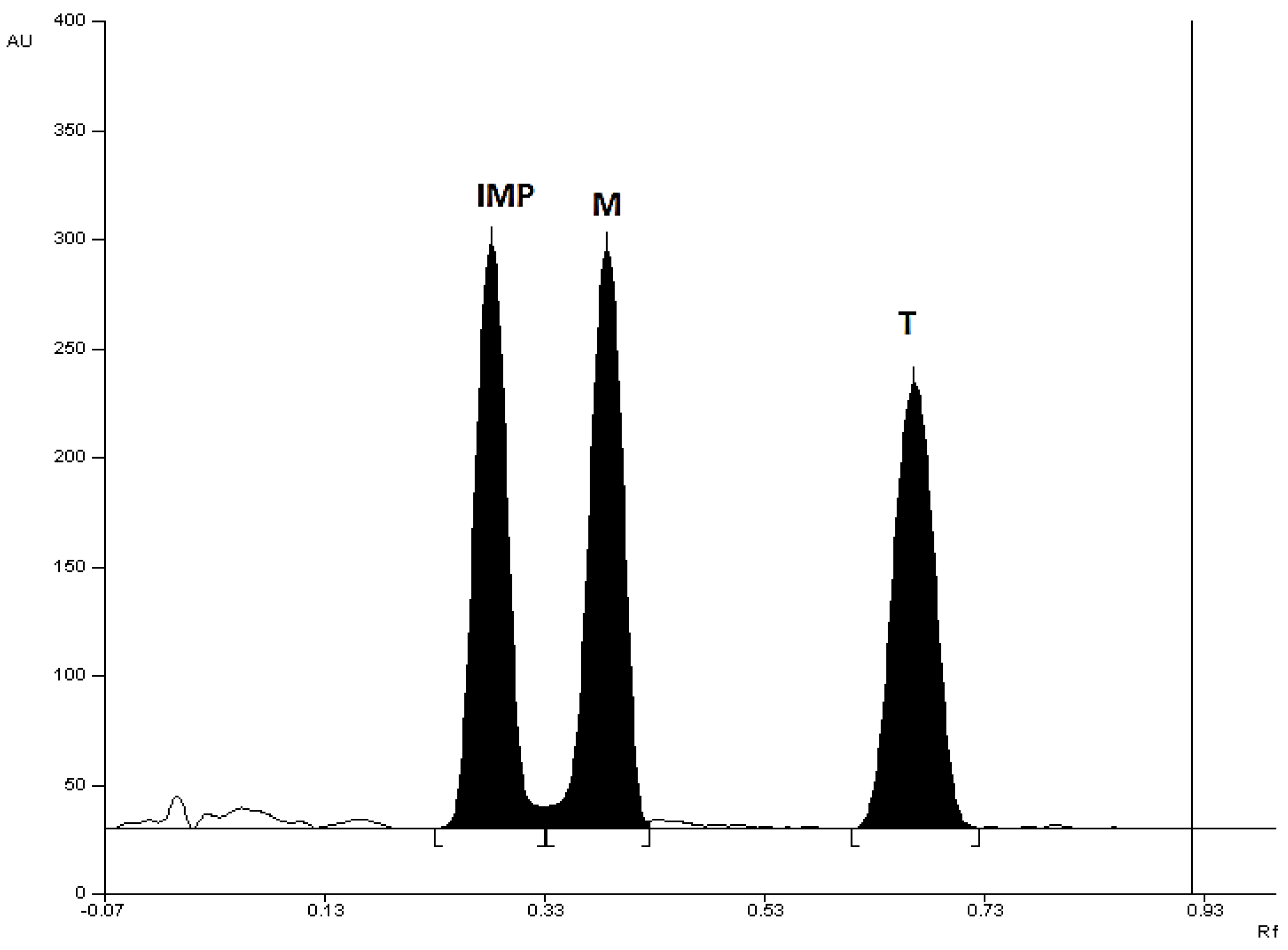
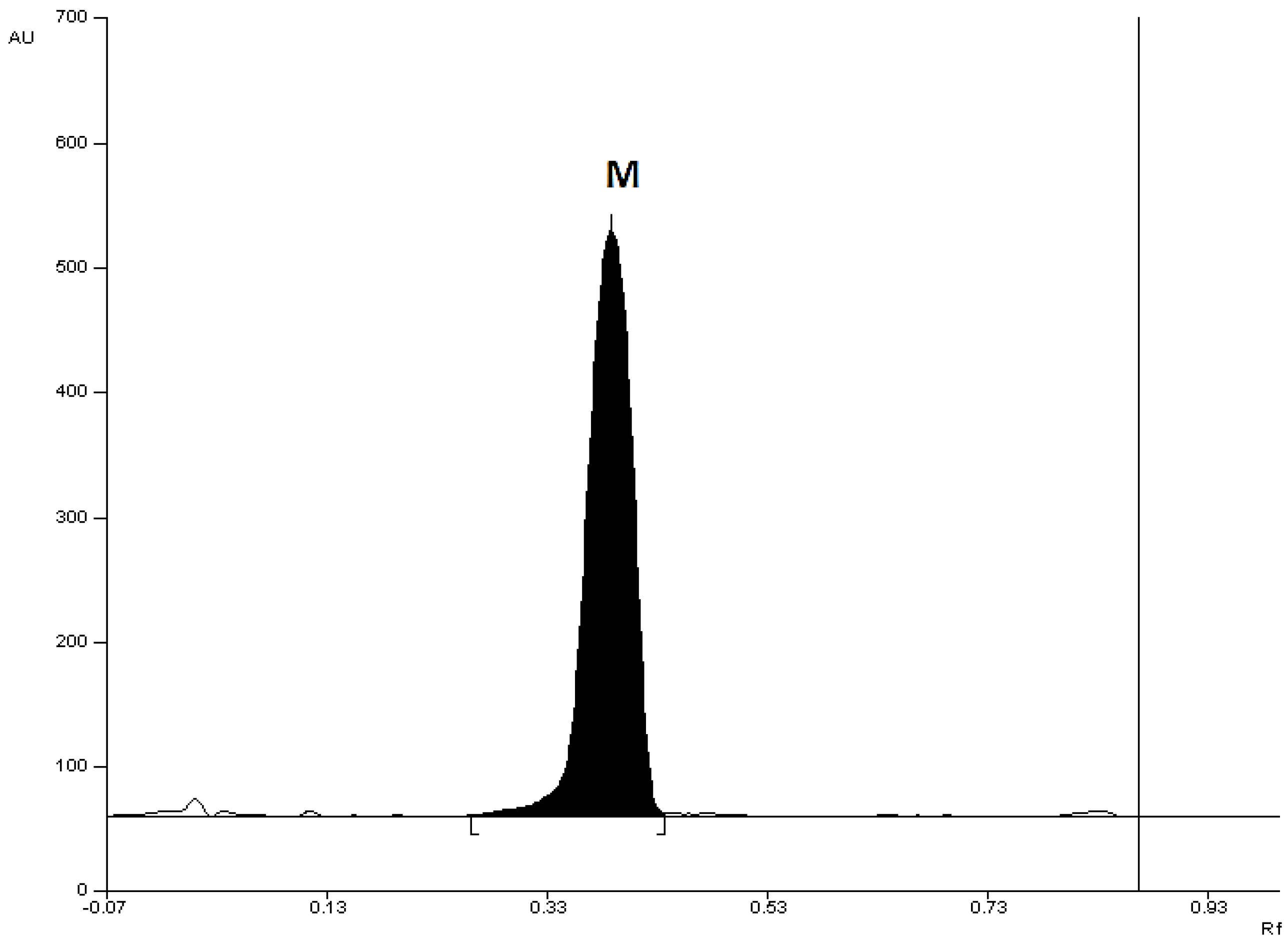

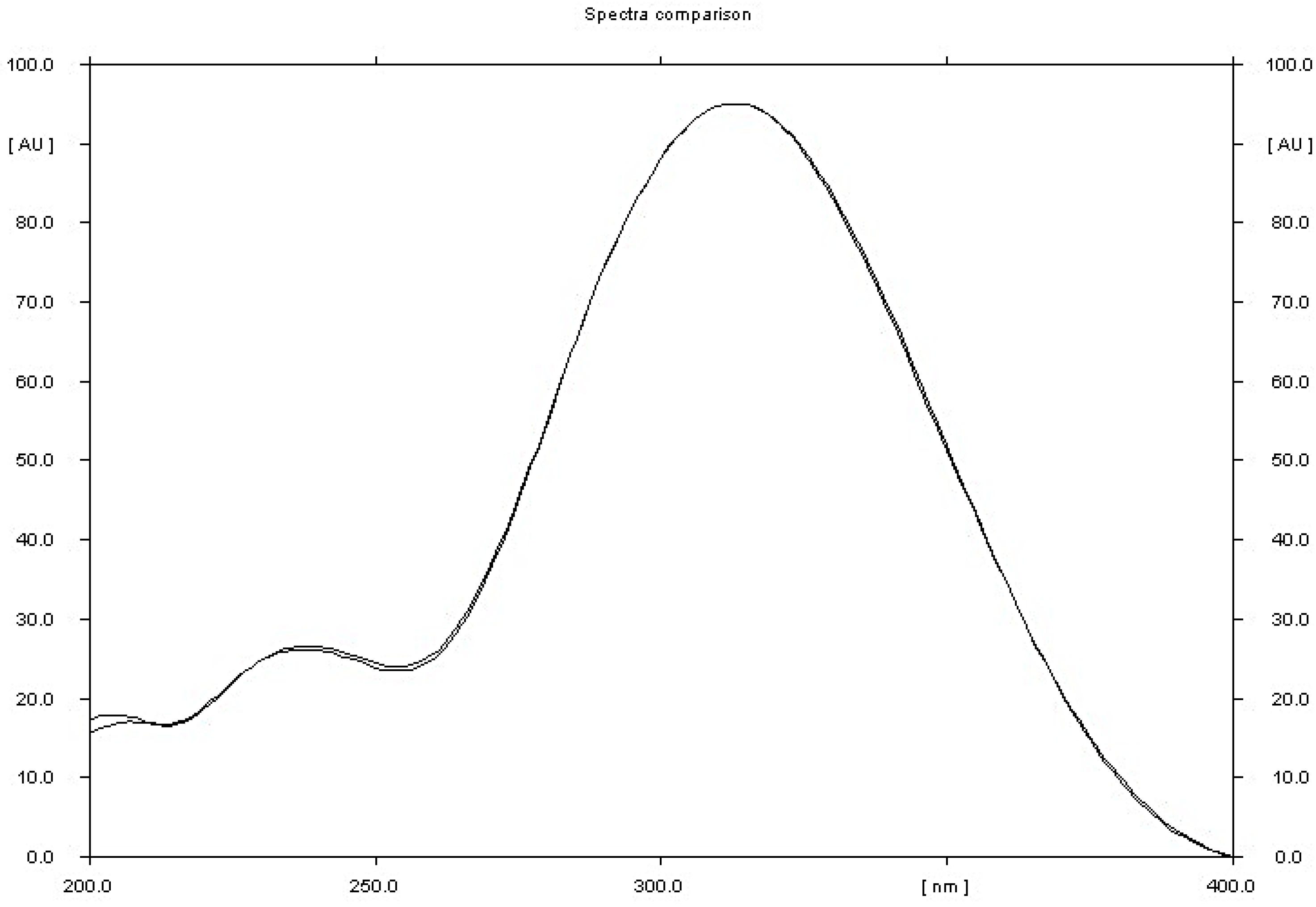
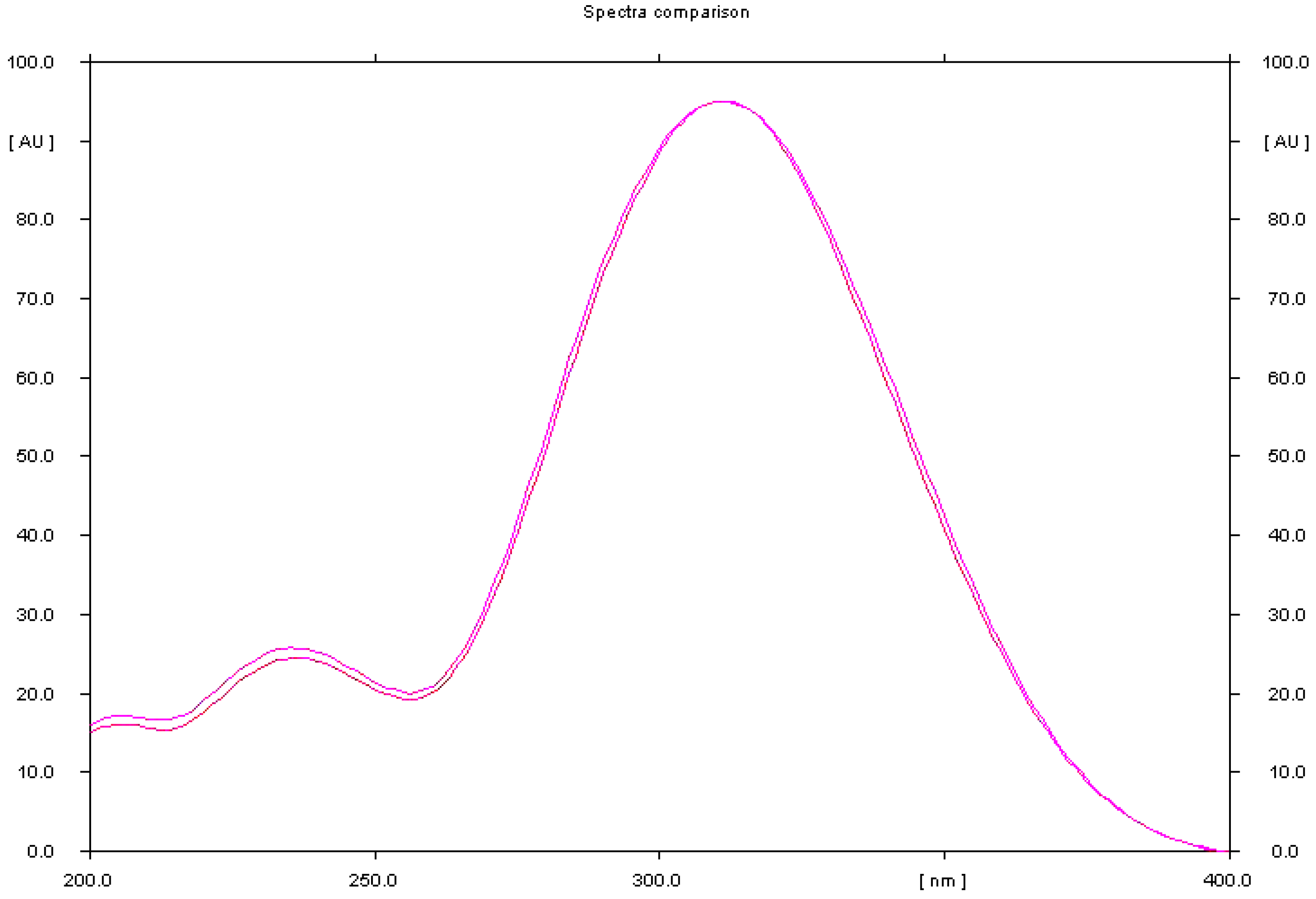

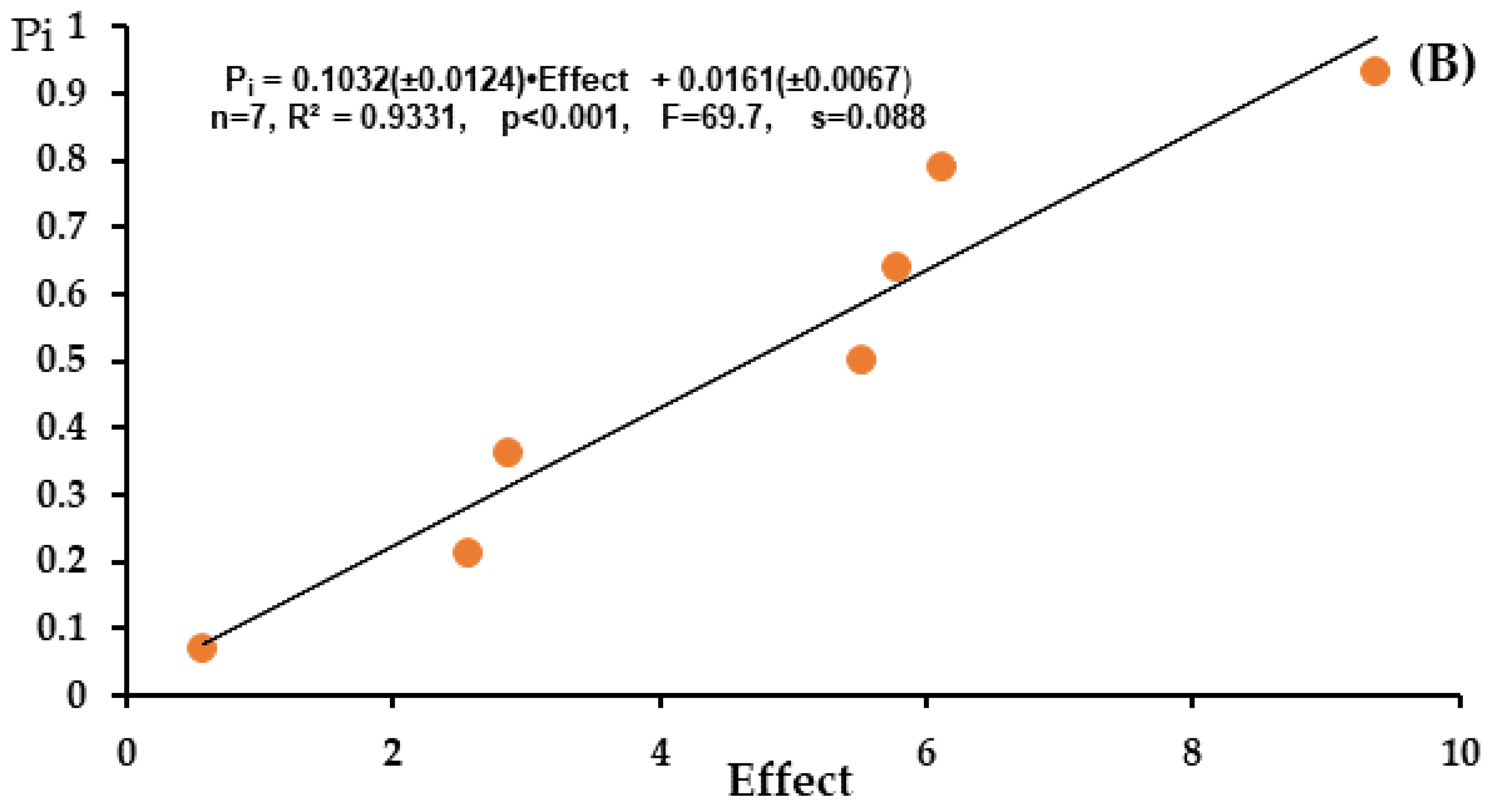
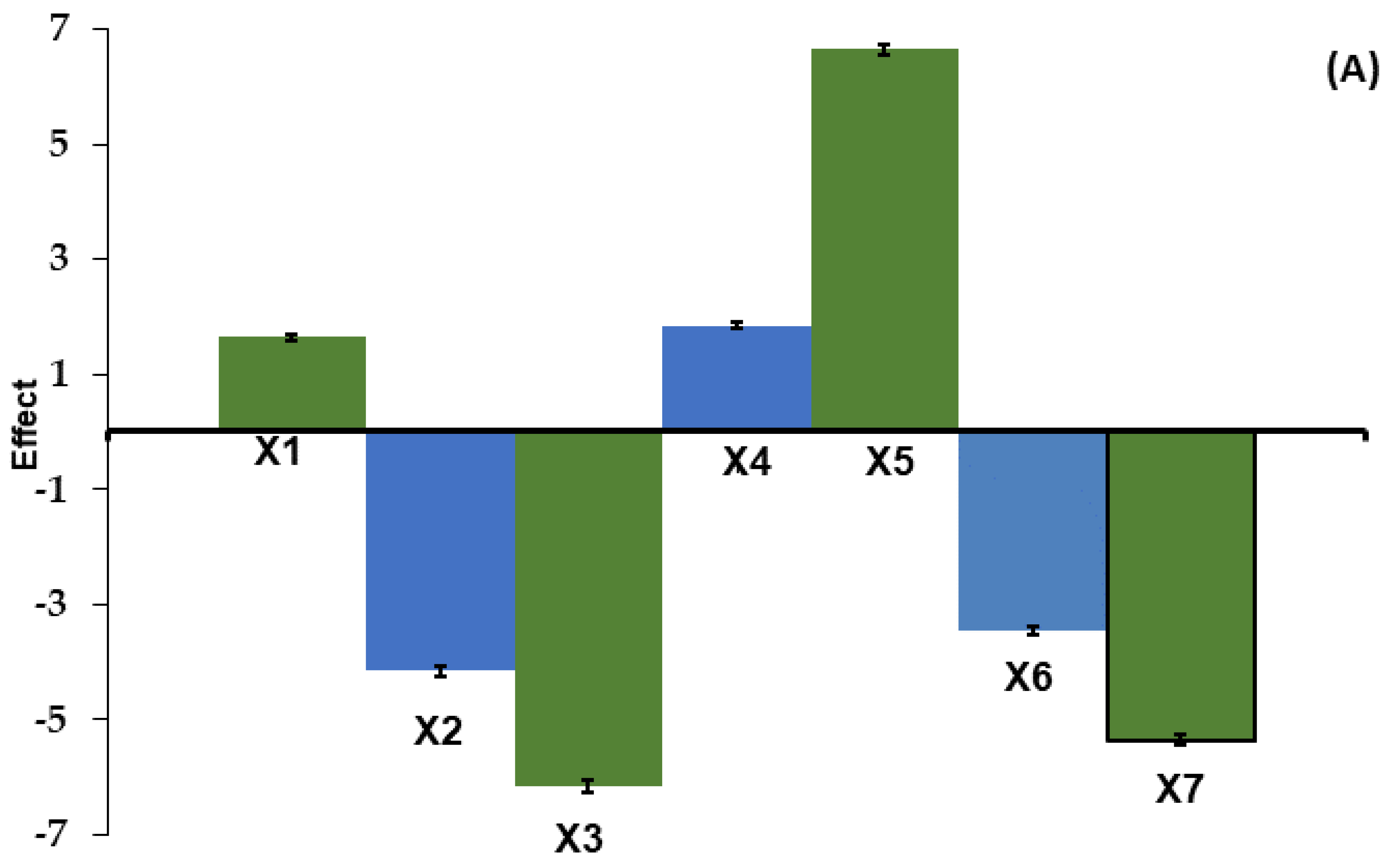

| No of Mobile Phase a | Average RF and Rs Values | |
|---|---|---|
| 2 | RF | RF(M) = 0.35 ± 0.02, RF(O) = 0.43 ± 0.02, RF(T) = 0.50 ± 0.02, RF(S) = 0.57 ± 0.02, RF(IMP) = 0.64 ± 0.03; |
| RS | RS(M/O) = 0.78, RS(O/T) = 0.77, RS(T/S) = 0.83, RS(S/IMP) = 0.80 | |
| 8 | RF | RF(IMP) = 0.36 ± 0.02, RF(M) = 0.41 ± 0.02, RF(O) = 0.46 ± 0.03, RF(S) = 0.51 ± 0.03, RF(T) = 0.59 ± 0.03; |
| RS | RS(IMP/M) = 0.75, RS(M/O) = 1.07, RS(O/S) = 1.05, RS(S/T) = 1.29 | |
| 9 | RF | RF(IMP) = 0.31 ± 0.02, RF(M) = 0.34 ± 0.02, RF(S) = 0.39 ± 0.02, RF(O) = 0.47 ± 0.03, RF(T) = 0.59 ± 0.03; |
| RS | RS(IMP/M) = 0.83, RS(M/S) = 1.27, RS(S/O) = 1.43, RS(O/T) = 1.78 | |
| 12 | RF | RF(M) = 0.45 ± 0.02, RF(IMP) = 0.49 ± 0.02, RF(O) = 0.55 ± 0.03, RF(S) = 0.65 ± 0.02, RF(T) = 0.74 ± 0.03; |
| RS | RS(M/IMP) = 0.83, RS(IMP/O) = 1.33, RS(O/S) = 1.33, RS(S/T) = 1.33 | |
| 13 | RF | RF(M) = 0.39 ± 0.02, RF(IMP) = 0.42 ± 0.02, RF(O) = 0.50 ± 0.03, RF(S) = 0.61 ± 0.02, RF(T) = 0.67 ± 0.02; |
| RS | RS(M/IMP) = 0.53, RS(IMP/O) = 1.18, RS(O/S) = 1.58, RS(S/T) = 1.13 | |
| 14 | RF | RF(M) = 0.28 ± 0.02, RF(S) = 0.35 ± 0.02, RF(T) = 0.41 ± 0.03, RF(O) = 0.47 ± 0.03, RF(IMP) = 0.56 ± 0.03; |
| RS | RS(M/S) = 0.88, RS(S/T) = 1.07, RS(T/O) = 1.07, RS(O/IMP) = 1.33 | |
| 16 | RF | RF(M) = 0.35 ± 0.02, RF(S) = 0.41 ± 0.02, RF(T) = 0.51 ± 0.02, RF(O) = 0.54 ± 0.02, RF(IMP) = 0.63 ± 0.03 |
| RS | RS(M/S) = 1.05, RS(S/T) = 1.44, RS(T/O) = 0.30, RS(O/IMP) = 1.20 | |
| 19 | RF | RF(IMP) = 0.30 ± 0.02, RF(M) = 0.38 ± 0.03, RF(S) = 0.44 ± 0.03, RF(O) = 0.51 ± 0.03, RF(T) = 0.70 ± 0.04 |
| RS | RS(IMP/M) = 1.33, RS(M/S) = 1.22, RS(S/O) = 1.29, RS(O/T) = 2.10 |
| Method Characteristic | 5-Nitroimidazole | ||
|---|---|---|---|
| Metronidazole | Tinidazole | ||
| Retardation factor (Rf) | 0.38 ± 0.03 | 0.70 ± 0.04 | |
| Range ([μg/spot)] | 0.2–2.0 | 0.2–2.0 | |
| Linearity ([μg/spot)] A = a·X + b | a | 7340.4 (±133.1) | 7828.0 (±114.2) |
| b | 3071.5 (±140.2) | 5567.9 (±130.1) | |
| n | 10 | 10 | |
| r | 0.9989 | 0.9992 | |
| s | 235.6 | 218.6 | |
| F | 3557 | 4701 | |
| p | <0.0001 | <0.0001 | |
| LOD ([µg/spot)] SD | 0.012 0.001 | 0.022 0.001 | |
| LOQ ([µg/spot)] SD | 0.036 0.003 | 0.066 0.003 | |
| For tablets | |||
| Accuracy (n = 6) | |||
| for 50% standard added | R = 103.8%; CV = 1.96% | R = 101.8%; CV = 0.95% | |
| for 100% standard added | R = 104.3%; CV = 1.13% | R = 99.1%; CV = 2.31% | |
| for 150% standard added | R = 101.2%; CV = 2.48% | R = 100.9%; CV = 2.49% | |
| Average recovery | 103.1% | 100.6% | |
| Precision (CV, ([%])) | |||
| Intraday (n = 3) | |||
| for 1.75 µg/spot | 1.08 | 0.76 | |
| for 1.00 µg/spot | 1.12 | 0.89 | |
| for 0.30 µg/spot | 0.99 | 1.28 | |
| Interday (n = 3) | |||
| for 1.75 µg/spot | 1.33 | 0.99 | |
| for 1.00 µg/spot | 1.39 | 1.44 | |
| for 0.30 µg/spot | 1.48 | 1.76 | |
| Robustness (CV, ([%])) | robust | robust | |
| Method | Mobile Phase | LOD and LOQ ([µg/spot)] | Ref. |
|---|---|---|---|
| Metronidazole | |||
| HPTLC | MeOH + TCM (9:1, v/v) | LOD = 0.61 LOQ = 0.95 | [18] |
| HPTLC | TLN + EA + MeOH + AM (3:1.5:0.5:0.1, v/v) | LOD = 0.046 LOQ = 0.116 | [19] |
| HPTLC | Bz + EA + TLN + MeOH + GAcOH (9.5:2:5:1.5:0.5, v/v) | LOD = 0.88 LOQ = 1.93 | [21] |
| TLC | ACN + AM + MeOH + MCL+ Hx (1.3:1.1:2:3:1, v/v) | LOD = 0.32 LOQ = 0.96 | [22] |
| TLC | EA + Ace + Hx + AM (9.5:0.5:0.3:0.3, v/v) | LOD = 0.13 LOQ = 0.38 | [23] |
| TLC | TCM + Ace + GAcOH (7.5:2.5:0.1, v/v) | LOD = 0.51 LOQ = 1.55 | [16] |
| TLC | TCM + MeOH (9:1, v/v) | LOD = 0.052 LOQ = 0.159 | [36] |
| Tinidazole | |||
| HPTLC | TLN + EA + MeOH + -TEA (5.5:1.0:1.0:0.1, v/v) | LOD = 0.011 LOQ = 0.037 | [25] |
| HPTLC | Ace + EtOH + 2% watery sodium dodecyl sulfate (WSDS) (3:4:2, v/v) | LOD = 0.0067 LOQ = 0.0203 | [33] |
| HPTLC | 30% Trifluoroacetic acid (TFAA) | LOD a = 0.01 LOQ a = 0.03 LOD b = 0.12 LOQ b = 0.36 | [32] |
| TLC | IP + butanol (BT) + AM + water (W) (25:50:5:25, v/v) | LOD = 0.1 LOQ = 0.3 | [30] |
| TLC | MCL + IP + ACN + AM (11:1.2:5:0.2, v/v) | LOD = 0.2 LOQ = 0.6 | [27] |
| TLC | TCM + MeOH (9:1, v/v) | LOD = 0.058 LOQ = 0.174 | [36] |
| Experiment No | X1 | X2 | X3 | X4 | X5 | X6 | X7 | Content of Active Pharmaceutical Ingredient (yi) ([mg·tablet−1]) | ||
|---|---|---|---|---|---|---|---|---|---|---|
| M | T | |||||||||
| 1 | + | + | + | + | + | + | + | 493.8 | 494.2 | |
| 2 | + | + | − | + | − | − | − | 489.9 | 502.5 | |
| 3 | + | − | + | − | − | + | − | 496.9 | 495.2 | |
| 4 | + | − | − | − | + | − | + | 500.2 | 506.1 | |
| 5 | − | + | + | − | + | − | − | 502.8 | 499.5 | |
| 6 | − | + | − | − | − | + | + | 493.1 | 490.2 | |
| 7 | − | − | + | + | − | − | + | 493.2 | 493.5 | |
| 8 | − | − | − | + | + | + | − | 513.8 | 508.2 | |
| Size of effect | M | −5.525 | −6.125 | −2.575 | −0.575 | 9.375 | 2.875 | −5.775 | ||
| T | 1.650 | −4.150 | −6.150 | 1.850 | 6.650 | −3.450 | −5.350 | |||
| The label claim ([mg)] | 500 | 500 | ||||||||
| Average amount ([mg]) | 498.0 | 498.7 | ||||||||
| Variance | 58.4 | 41.7 | ||||||||
| Standard deviation (SD) | 7.64 | 6.46 | ||||||||
| Coefficient of variation (CV, %) | 1.5 | 1.3 | ||||||||
| Metronidazole | Tinidazole | |||
|---|---|---|---|---|
| Method | ||||
| A | B | A | B | |
| Number of analyses | 10 | 10 | 10 | 10 |
| 1 | 510.3 | 528.6 | 489.9 | 492.5 |
| 2 | 523.0 | 506.4 | 495.2 | 488.9 |
| 3 | 520.0 | 521.5 | 492.3 | 512.6 |
| 4 | 495.6 | 516.2 | 487.6 | 501.8 |
| 5 | 503.6 | 508.3 | 502.6 | 481.7 |
| 6 | 488.4 | 498.2 | 509.9 | 479.6 |
| 7 | 520.1 | 501.3 | 487.1 | 509.9 |
| 8 | 515.3 | 496.3 | 512.3 | 508.1 |
| 9 | 491.7 | 517.8 | 507.8 | 505.5 |
| 10 | 496.7 | 497.5 | 508.8 | 491.8 |
| Average | 506.5 | 509.2 | 499.4 | 497.2 |
| Label claimed | 500 | 500 | 500 | 500 |
| Amount of metronidazole and tinidazole (%) in relation to the label claim | 101.3 | 101.8 | 99.8 | 99.4 |
| Standard deviation (SD) | 12.9 | 11.3 | 10.0 | 11.9 |
| Coefficient of variation (CV, %) | 2.55 | 2.22 | 2.00 | 2.39 |
| Confidence interval of arithmetic mean with confidence level equal to 95% | µ = 506.5 ± 9.2 | µ = 509.2 ± 8.1 | µ = 499.4 ± 7.2 | µ = 497.2 ± 8.5 |
| t calculated | 0.497 | 0.447 | ||
| t(95%·18) tabulated | 2.101 | 2.101 | ||
| F calculated | 1.30 | 1.42 | ||
| F(95%·f1 = f2 = 9) tabulated | 3.18 | 3.18 | ||
Disclaimer/Publisher’s Note: The statements, opinions and data contained in all publications are solely those of the individual author(s) and contributor(s) and not of MDPI and/or the editor(s). MDPI and/or the editor(s) disclaim responsibility for any injury to people or property resulting from any ideas, methods, instructions or products referred to in the content. |
© 2024 by the author. Licensee MDPI, Basel, Switzerland. This article is an open access article distributed under the terms and conditions of the Creative Commons Attribution (CC BY) license (https://creativecommons.org/licenses/by/4.0/).
Share and Cite
Pyka-Pająk, A. Sensitive and Cost-Effective TLC-Densitometric Method for Determination of Metronidazole and Tinidazole in Tablets. Processes 2024, 12, 643. https://doi.org/10.3390/pr12040643
Pyka-Pająk A. Sensitive and Cost-Effective TLC-Densitometric Method for Determination of Metronidazole and Tinidazole in Tablets. Processes. 2024; 12(4):643. https://doi.org/10.3390/pr12040643
Chicago/Turabian StylePyka-Pająk, Alina. 2024. "Sensitive and Cost-Effective TLC-Densitometric Method for Determination of Metronidazole and Tinidazole in Tablets" Processes 12, no. 4: 643. https://doi.org/10.3390/pr12040643
APA StylePyka-Pająk, A. (2024). Sensitive and Cost-Effective TLC-Densitometric Method for Determination of Metronidazole and Tinidazole in Tablets. Processes, 12(4), 643. https://doi.org/10.3390/pr12040643






